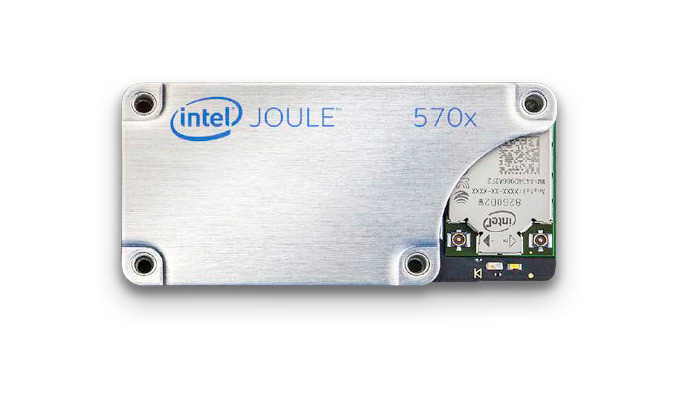Intel Unveils Joule: A High-Performance Atom-Powered IoT Module & Maker Kit
by Ryan Smith on August 17, 2016 4:30 AM EST
Today at Intel’s annual Developer Forum, the hardware manufacturer announced the latest in their Internet of Things-focused product kits: Joule. Based around Intel’s canceled-but-not-quite Broxton Atom processor, Joule is designed to further augment Intel’s existing lineup of kits by offering a much higher performance part based on the latest generations of the company’s technologies.
Back in 2013 Intel announced Galileo, the first of what has become a collection of IoT kits/platforms for hardware developers. Galileo and its compatriots Edison and Curie turned out to be solid hits for the company – even with competing kits already on the market – driving a big part of Intel’s overall IoT growth in recent years. The System on Module boards proved popular with tinkers and product developers alike who needed small systems for everything from small prototypes to a commercial off the shelf boards.
| Intel IoT Kits | |||||
| Joule 570X | Joule 550X | Edison | |||
| SoC | Intel Atom "Broxton-M" T5700 |
Intel Atom "Broxton-M" T5500 |
Intel Atom "Tangier" Z34xx |
||
| CPU | 4x Goldmont @ 1.7GHz, Turbo to 2.4GHz | 4x Goldmont @ 1.5GHz | 2x Silvermont @ 500MHz 1x Quark @ 100MHz |
||
| GPU | Intel Gen9 | Intel Gen9 | N/A | ||
| RAM | 4GB LPDDR4 | 3GB LPDDR4 | 1GB LPDDR3 | ||
| Storage | 16GB eMMC | 8GB eMMC | 4GB eMMC | ||
| Wireless | 802.11ac w/MIMO + BT 4.1 | 802.11n + BT 4.0 | |||
| I/O | UART + GPIO + I2C + MIPI CSI + MIPI DSI + USB 3.0 | SD + UART + SPI + GPIO + USB 2.0 OTG | |||
| Dimentions | 48 x 24 x 5 mm | 35.5 x 25 x 3.9 mm | |||
Joule then extends Intel’s presence in this market by offering a higher performing part in their IoT portfolio. Whereas the previous top-tier Edison board used a combination of Atom Silvermont and Quark CPU cores and paired this up with a respectable amount of RAM, NAND, and I/O options, Joule goes much further. The SoC at the heart of the board is Intel’s Broxton-M, which although was canceled for consumer devices, as we can now see will instead be making a home for itself within Intel’s IoT product family.
Intel is offering two different versions of the Joule board. Both use the same SoC, but they vary in clockspeeds and memory. The more powerful of the two, Joule 570X, uses what Intel is calling a Atom T5700, which is a quad core Goldmont Atom configuration with a base clock of 1.7GHz and can turbo to 2.4GHz. This in turn is paired with 4GB of LPDDR4 memory and a 16GB eMMC NAND module for non-volatile storage. Meanwhile the Joule 550X drops the quad core Atom to 1.5GHz with no turbo, and features 3GB of LPDDR4 memory along with 8GB of NAND.
Both Joule boards also feature the same I/O connectivity. On the wireless side, this is composed of a radio supporting Bluetooth 4.1 and 802.11ac (MIMO is listed supported, so I’m wagering this is a 2 spatial stream solution). And on the wired side, USB 3.0 is supported, along with the vast collection of GPIOs, UARTs, and MIPI’s camera (CSI) and display (DSI) interfaces.
The Joule module itself is said to only be a bit larger than the Edison module – which was usually measured relative to a postage stamp – and in the brief glimpse of the module we got when Brian Krzanich held it out on stage, I’d say we’re looking at something not too much bigger than a stick of gum (or perhaps the old Sony memory stick). Intel hasn’t released the full documentation for the kit yet, so we don’t have power consumption information available, but given the higher performance goals for the kit (and the quad Goldmont CPU cores), it’s a fair bet that it’s going to be higher than Edison.
As you might expect from the specifications, Intel is aiming Joule at a higher performance class of use cases. Ultimately as a maker kit it’s a bit of an “if you build it” situation – it’s up to developers to figure out what to do with it – but Intel sees it as being useful for drones, AR/VR, robotics, and for the first time in one of their IoT products, computer vision. While we don’t have a ton of hard details on the underlying iGPU, it is powerful enough for certain CV tasks, and it supports both 4K video capture and display. It also supports Intel’s RealSense camera, giving developers the option of using the underlying depth sensing capabilities for improved vision/analysis.
Finally, on the software side of matters, the Joule will support a few different OSes. The boards will default to a new Linux distribution specifically designed for the hardware that Intel is calling Reference Linux OS for IoT, and Cannonical’s “Snappy” Ubuntu Core is also supported. Meanwhile Microsoft’s Windows 10 IoT Core is also supported for developers who need Windows interoperability.
Wrapping things up, along with today’s announcement, Intel has already begun selling one of the Joule SKUs, with the others to follow. The Joule 570X development kit, which includes the Joule module, carrier board, WiFi antennas, and other components is on sale today at IDF for $369, and will be available through Intel’s partners next month. At that price it’s fair to say that Intel is not aiming to have Joule compete with more mainstream kits – or even their own Edison kit – but rather at the more upscale kits such as the (even more expensive) NVIDIA Jetson TX1, which is a much tighter market in terms of the number of competitors.
Meanwhile the lower-end 550X development kit and the stand-alone Joule modules are scheduled for release in Q4. Pricing for those products has not yet been disclosed, though given the intent for Joule to be used in mass production devices, it’ll be interesting to see what Intel prices the stand-alone modules at.
Source: Intel












60 Comments
View All Comments
smilingcrow - Wednesday, August 17, 2016 - link
I normally just ignore them but made the mistake of reading one. Never again, just wish there was an ignore feature.ddriver - Wednesday, August 17, 2016 - link
If you are so enlightened, humor me what's great or even exclusive about realsense? Google and M$ have already developed pretty much identical technology, just under different trademarks. And it is nothing new either, that stuff has been around for many years, it is really only new to geniuses like you. Consumerist fanboys rejoice as corporations put fancy names on tech that has been around for a while, and somehow it is new and great. But it new only to you, because you are far behind the curve, and although the tech has great potential, it will end up milking idiots far more than it empowers people, like every bit of technology that fell victim to the greedy corporations.name99 - Thursday, August 18, 2016 - link
Look, the issue is not @ddriver's personality. It's not even the quality of the board. It is the RELEVANCE of the board to the supposed target market.If Intel want to sell a board to high-end hobbyists fine. But selling a high-end hobbyist board and claiming it is for IoT is just stupid.
It's like Apple claiming that iPad's are servers. Yes, sure you could probably run some server software on an iPad, but doing so would be retarded, and calling an iPad a server is utterly unhelpful in describing the nature of the product.
Likewise to claim that these boards are IoT boards is utterly unhelpful in describing their nature --- it is marketing jumping on a buzzword band-wagon, and I have no problem with @ddriver pointing out how stupid it is. We should all have a very low tolerance for marketing BS.
jospoortvliet - Sunday, August 21, 2016 - link
Amen. It is a shame anandtech.com doesn't call this out.Vatharian - Wednesday, August 17, 2016 - link
Ram is Package-on-Package, so no space is wasted. This board may be big, but for connectivity it tramples every SBC available (sans SATA), no to mention that they still managed to keep power consumption in check. It's also clearly aimed at more intensive tasks. With support for RealSense, I'd suspect it will be powerful enough to build a drone that can find it's way in a building on its own, which was impossible without using IR depth cameras so far (and often, offloading the calculations). I'm inclined to try!jospoortvliet - Sunday, August 21, 2016 - link
Yeah, it does look nice for that use case though I suspect it would have to be a pretty big drone to be able to deliver the juice this thing needs. At least I suspect we are talking >1 watt which puts it out of reach for many typical drones.psychobriggsy - Wednesday, August 17, 2016 - link
I agree, I'm trying to think of the "thing" that this would be used in that needs to be internet enabled.This is a tablet without a screen really. I can see some hobbyist uses (although I suspect at the price, pretty much every ARM SBC would be more attractive) but you're not going to be internet enabling your fridge with this. Well, maybe if you want to talk to the fridge or show it what you've just taken out that needs adding to the shopping list, and all the voice analysis or image analysis is done on the SBC itself.
Meteor2 - Wednesday, August 17, 2016 - link
Pretty much any vehicle and any part in the power grid stands to benefit through remote/autonomous operation optimisation.name99 - Thursday, August 18, 2016 - link
Maybe so, but that doesn't show that these boards are appropriate for the task.Most power grid stuff (I assume you mean things like air con being signalled over the grid to run at lower power during high demand) doesn't need nearly this level of performance (and cost).
Meanwhile auto is either interior (DVD player and UI) which can be done a whole lot more cheaply on ARM, or is sensors and autonomous driving (which does need performance, but doesn't need Windows, so again paying the x86 tax doesn't make sense; a high end ARM plus GPUs is a better fit).
damianrobertjones - Wednesday, August 17, 2016 - link
I was with you until you wrote 'windoze'. Come on just grow up already.